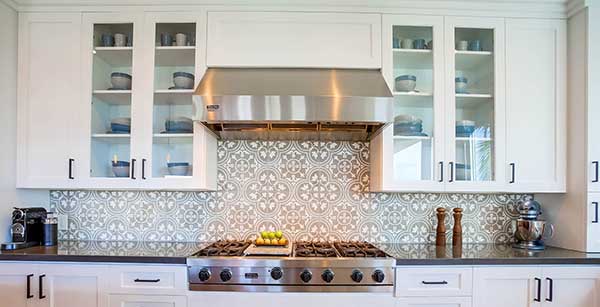Fine cabinet making and an ingrained knowledge of stained wood cuts go hand in hand.
Have you ever wondered why wood looks a certain way when stain is applied? Are those stain results planned or by chance … or a little of both?
Of course, master cabinet makers and designers like those at Holland’s Custom Cabinets know those answers and more. They also know how wood staining and the choice of wood cuts are critical to getting cabinet design and finishes right from the outset. After all, when staining wood, unlike painting it, there are rarely opportunities for do-overs.
Work with an experienced cabinet maker or designer and you’ll discover firsthand the transformative power of natural wood stain. The right expertise, the right stain, and the right technique can literally unlock the soul of stained wood kitchen cabinets.
With that in mind, let’s explore how stains and various types of wood cuts can shape both the aesthetics and the functionality of custom cabinets.
Understanding Stained Wood Cuts for Cabinets
Stained wood is a popular way to enhance custom cabinetry. As such, understanding the characteristics of common Rotary, Quarter, and Rift Cuts is critical for achieving the perfect wood stain finish as each plays a distinct role in wood staining.
- Rotary Cuts produce bold, swirling patterns.
- Quarter Cuts result in vertical, straight grain patterns.
- Rift Cuts, which are variations of quarter cuts, produce more linear and subdued grain patterns compared to quarter cuts.
With each cut having such distinct characteristics and effects, the choice of stained wood cuts for stained wood kitchen cabinets or other cabinetry projects has a huge impact.
Of course, choosing the right cut of wood for cabinet construction goes well beyond aesthetics. Wood cuts also greatly impact durability and longevity by affecting stability, wear resistance, and resistance to decay. Quarter and rift cuts, with vertical grain patterns, often result in more stable wood, while quarter-sawn wood tends to be harder and more wear-resistant. Additionally, the presence of heartwood in certain cuts can enhance resistance to decay and insects.
Rotary Cut: Unveiling Unique Patterns
The Rotary Cut method is known for precision and distinctiveness. This cut involves rotating a log against a fixed blade to reveal exquisite patterns in the wood grain. The result? Mesmerizing, stained wood cuts that add a touch of elegance to any project.
The charm of the Rotary Cut lies in its ability to showcase diverse patterns, making it a highly preferred choice for wood finish enthusiasts. This technique is particularly suitable for highlighting the natural beauty of wood. Holland’s often uses Rotary Cuts when intricate patterns are desired to enhance the overall aesthetic of stained wood kitchen cabinets.
From creating eye-catching wood cuts to achieving interesting wood stain finishes, Rotary Cuts offer versatility. Its compatibility with various wood species also makes it an ideal choice when experimenting with natural wood stains.
Quarter Cut: Classic Elegance in Grain
Quarter Cuts impart a timeless charm and refined appearance that enhances the beauty of wood. This wood finish method involves first quartering a log and then cutting each quarter separately into boards. Boards cut using this technique tend to be expensive due to the amount of waste produced during the cutting process.
Quarter Cut boasts distinctive features, showcasing a straight grain with striking medullary rays. Wood staining quarter cut boards brings out the best in fine-grained hardwoods, such as oak and cherry, while natural wood stains accentuate the wood’s inherent characteristics, providing a sophisticated finish.
Well-suited for stained wood kitchen cabinets, this method can elevate practically any space with the charm of finely crafted wood.
Rift Cut: Modern Simplicity and Durability
A variation of the Quarter Cut method, Rift Cut wood marries modern simplicity with durability. Unlike other stained wood cuts, Rift Cuts are quite precise and designed to enhance natural grain patterns for staining. Rift Cuts result in distinctive, angled, linear patterns that produce a refined, contemporary look.
As such, this type of cut is much-sought-after for interiors, especially for stained wood kitchen cabinets. Even as demand for more and more distinctive wood cuts has risen, the Rift Cut remains a sophisticated choice for many.
Choosing the Right Cut for Your Project
With any woodworking project, whether it’s in a classic or modern setting, the synergy between wood cuts and wood finishes plays a key role.
The choice of wood cut is critical for achieving the desired look, feel, and level of durability. For example, understanding wood movement and stability is crucial for preventing issues such as warping or splitting over time.
Another factor to consider is the right wood finish for the project. Whether you’re going for a natural wood stain look or a more robust stained wood cut, the choice greatly influences overall results.
Every Project a Masterpiece
As you can see, the versatility of stained wood cuts is a testament to the transformative power of wood staining. Knowing about the various types of wood cuts can help you make better, more informed choices that ultimately impact the look and feel of your stained wood kitchen cabinets and your satisfaction with them. Every project can become a masterpiece with the right wood finish and with the right experts designing, manufacturing, and installing it.
At Holland’s Custom Cabinets, we acknowledge the importance our clients place on achieving the perfect blend of visual appeal and practicality. We invite you to reach out to us to discuss how wood cuts and stains can help revive your kitchen, bathroom, or other living space. Call us at 619.443.6081 or fill out our online form to get started.


